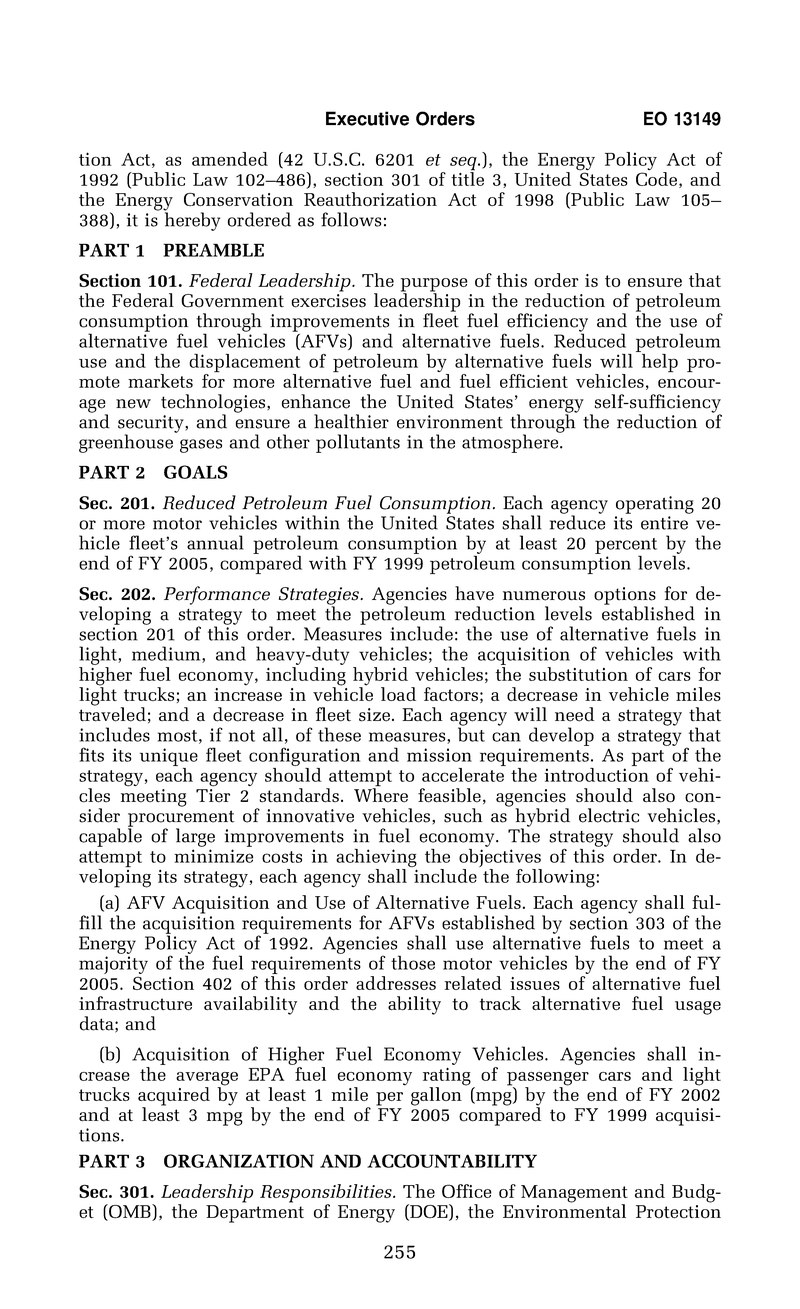tion Act, as amended (42 U.S.C. 6201 et seq.), the Energy Policy Act of 1992 (Public Law 102-486), section 301 of title 3, United States Code, and the Energy Conservation Reauthorization Act of 1998 (Public Law 105-388), it is hereby ordered as follows:
PART 1 PREAMBLE
Section 101. Federal Leadership. The purpose of this order is to ensure that the Federal Government exercises leadership in the reduction of petroleum consumption through improvements in fleet fuel efficiency and the use of alternative fuel vehicles (AFVs) and alternative fuels. Reduced petroleum use and the displacement of petroleum by alternative fuels will help promote markets for more alternative fuel and fuel efficient vehicles, encourage new technologies, enhance the United States' energy self-sufficiency and security, and ensure a healthier environment through the reduction of greenhouse gases and other pollutants in the atmosphere.
PART 2 GOALS
Sec. 201. Reduced Petroleum Fuel Consumption. Each agency operating 20 or more motor vehicles within the United States shall reduce its entire vehicle fleet's annual petroleum consumption by at least 20 percent by the end of FY 2005, compared with FY 1999 petroleum consumption levels.
Sec. 202. Performance Strategies. Agencies have numerous options for developing a strategy to meet the petroleum reduction levels established in section 201 of this order. Measures include: the use of alternative fuels in light, medium, and heavy-duty vehicles; the acquisition of vehicles with higher fuel economy, including hybrid vehicles; the substitution of cars for light trucks; an increase in vehicle load factors; a decrease in vehicle miles traveled; and a decrease in fleet size. Each agency will need a strategy that includes most, if not all, of these measures, but can develop a strategy that fits its unique fleet configuration and mission requirements. As part of the strategy, each agency should attempt to accelerate the introduction of vehicles meeting Tier 2 standards. Where feasible, agencies should also consider procurement of innovative vehicles, such as hybrid electric vehicles, capable of large improvements in fuel economy. The strategy should also attempt to minimize costs in achieving the objectives of this order. In developing its strategy, each agency shall include the following:
(a) AFV Acquisition and Use of Alternative Fuels. Each agency shall fulfill the acquisition requirements for AFVs established by section 303 of the Energy Policy Act of 1992. Agencies shall use alternative fuels to meet a majority of the fuel requirements of those motor vehicles by the end of FY 2005. Section 402 of this order addresses related issues of alternative fuel infrastructure availability and the ability to track alternative fuel usage data; and
(b) Acquisition of Higher Fuel Economy Vehicles. Agencies shall increase the average EPA fuel economy rating of passenger cars and light trucks acquired by at least 1 mile per gallon (mpg) by the end of FY 2002 and at least 3 mpg by the end of FY 2005 compared to FY 1999 acquisitions.
PART 3 ORGANIZATION AND ACCOUNTABILITY
Sec. 301. Leadership Responsibilities. The Office of Management and Budget (OMB), the Department of Energy (DOE), the Environmental Protection
